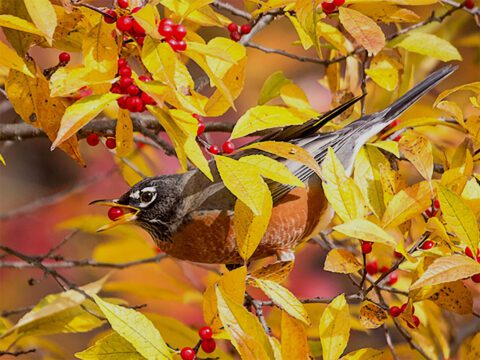Saving the Tropics One Sip at a Time with Bird-Friendly Coffee
January 15, 2009

Certified coffee protects Neotropical birds
Coffee is the number one food import into the United States, and tropical land continues to be deforested for plantations to fulfill the demand. Native wild coffee plants required shade, and so were traditionally cultivated in tropical forest understories. These shade-grown coffee farms were sustainable and environmentally friendly, providing habitat for many plants and animals. The rain and humidity associated with many tropical forests minimized the need for irrigation. Naturally decaying tropical vegetation minimized the need for fertilizers. And the variety of natural tropical plants and wide spacing among coffee plants minimized the need for pesticides.
To maximize the amount of coffee produced per acre, coffee cultivars were developed that could be planted in the sun as row crops. More and more rain and cloud forest were cleared for coffee production, which has caused many more problems than just habitat destruction. Rainfall and cloud patterns in much of the tropics are a result of transpiration of tropical plants rather than broader weather patterns, and so clearing these moist forests has led to reduced cloud cover and rainfall in wide swaths of surrounding natural habitat as well as the plantations themselves. Monocultures of any kind are vulnerable to pests, and so pesticides are typically applied; coffee grown in the understory of natural tropical forests is more naturally protected from pests. And without the leaf litter of a natural forest, coffee plantations must be fertilized; even so, when the soil becomes depleted and coffee farms abandoned, it may take decades for forest to regenerate.
The Smithsonian Migratory Bird Center has developed the only 100 percent-organic shade-grown coffee certification. Their “Bird Friendly®” seal of approval guarantees that the coffee was grown on a sustainable, organic farm using the safest techniques.
Julie Craves, supervisor of avian research at the Rouge River Bird Observatory at the University of Michigan-Dearborn, research associate at the university’s Environmental Interpretive Center, and columnist for Birder’s World, has made a number of trips to Cuba developing bird-survey routes and protocols to be used by future environmental tourists and educational groups to assess the health of bird populations in Cuba. In the course of her work, she has focused a great deal of attention and research on coffee plantations.
“People really need to pay attention to the issues surrounding coffee production and educate themselves,” she says. “Because there is no legal definition of “shade coffee,” and environmental coffee certification is really still young and covers such a small proportion of the world’s coffee crop, people have to care enough to learn how to choose sustainably-grown coffee and not just give up if they don’t find a special “seal” on the package. One simple rule is: if it’s really cheap, it’s not sustainable.” It’s important to remember that “cheap” coffee is only inexpensive because the environment, including tropical birds, not the consumer, is paying much of the cost.
We can help by buying sustainably grown shade coffee, and educating others about the issue. Author and conservationist Paul Baicich says, “About a century ago, our bird-watching foremothers launched a conservation movement to save birds by shaping buying habits and demanding change: stopping the use of feathers in women’s wear. Today, we can revive that same concern and enthusiasm by changing current consumer habits in the area of bird-compatible, shade-grown coffee aimed at saving birds in the Neotropics.”
Originally published in the WInter 2009 issue of BirdScope.


All About Birds is a free resource
Available for everyone,
funded by donors like you






